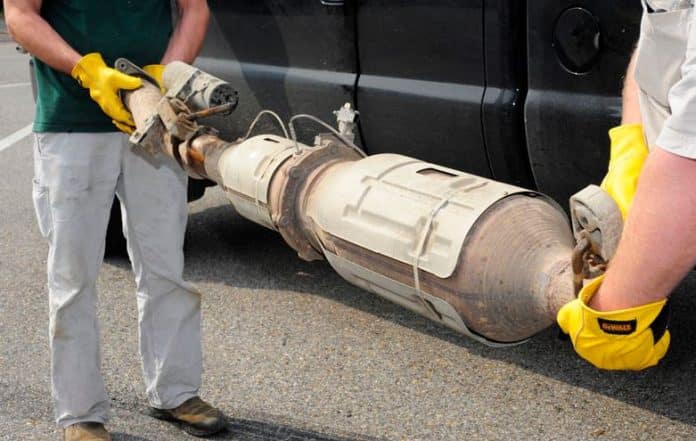
Table of Contents
All the emissions technology on your truck including the DPF, DOC, SCR, and EGR live by one simple principle as stated by Benjamin Franklin:
“An Ounce of Prevention is worth a Pound of Cure”.
That’s why it’s a good idea you pickup a diesel exhaust fluid refractometer in the course of your DPF maintenance journey.

What does DIESEL PARTICULATE FILTER mean
Let’s face it, nobody wants extra equipment that slows down, bogs, and hinders the performance of your heavy truck. However, emissions technology is mandated by the LAW.
It is illegal to DPF delete
Should I Delete My DPF? The Truth about Diesel Emissions
The website gives easy to consume information on alternatives to a DPF delete kit and highlights the expensive fines and legal action that can be brought against those that violate regulated-by-law, emissions control technology.
Don’t be the fool that gets tricked into removing the emissions technology on your truck, avoid fines and legal action and Do Not DPF Delete!
What is a Diesel Particulate Filter?
A diesel particulate filter (DPF) is a device designed to remove soot from the exhaust gas of a diesel vehicle.
Diesel engines do not combust completely and produce a variety of particles as a result. The consequences of incomplete combustion are the emission of soot also known as black carbon.
Newer, modified particulate filters can capture up to 95% of black carbon soot.
There are many types of DPF filters on the market: The most common type of diesel particulate filter is made of a ceramic material known as cordierite. How does a dpf filter work
Cordierite filters can effectively filtrate particulate matter but the main problem with it is the low melting point of the ceramic material.
If the content reaches its melting point, substrates of it can leak into the fuel-air mix and further complicate the filtering process.
The melting point is usually achieved during regeneration. Regeneration is the process of melting the soot to leave behind only ash.
Silicon carbide wall flow filters are the second most common type of DPFs. Silicon carbide has a high melting point and is usually more expensive.
Are You Maintaining Your DPF?
Regeneration is the removal of accumulated soot from the filter through a process of burning it into an ash-like residue.
There are three types of regeneration modes, active, passive, and forced. It will often be displayed on the onboard diagnostics as ‘REGEN’.

Dpf maintenance regen
If you regeneration system is not working, it is essential you get it fixed to avoid further damage to your expensive DPF.
Usually, REGEN stops work due to a faulty sensor, so it is crucial you get it checked out by a diesel engine mechanic.
One important thing to note is the use of extra fuel facilitates the burning. The extra fuel is used to heat the DPF to burn the soot. As a result, DPF equipped trucks are bound to boost lower fuel mileage.
However, this is entirely dependent upon how often the regeneration kicks in on your DPF.
To lower the number of required times REGEN is necessary on your truck, we suggest you use a particular diesel additive known as Secret Diesel Extreme that you can regularly add to your regular diesel tank to lower regeneration cycles by up to 50% by keeping your DPF healthy!
U.S Regulations on Diesel Emissions
The US has been gravely affected by this ongoing emissions problem resulting from diesel vehicles.
In fact, Rocky Mountain National Park and Yellowstone National Park have experienced up to 3.4 degrees F higher temperatures and fewer days of freezing per year.
The temperatures have been the highest in the past 50 years which is a significant concern.
Black Carbon and Climate Change
Based on the study conducted by Dieselforum.org, diesel contributes up to 25% to the global sources of black carbon.
Black carbon is a significant contributor to climate change, the progressive increase in global temperatures due to the melting of the polar ice-caps.
Millions of people each year suffer pre-mature deaths due to growing air pollution. The particulate matter (PM 2.5) that results due to the combustion of diesel has the potential to penetrate deep into the tissues of the lungs, causing significant damage.
It also aggravates asthma, bronchitis, and existing heart conditions. The sulfurs that are present in pollution have been an ongoing concern.
Emission Standards
Below, we display a summary of emission standards in the United States. This is a list of the current mandatory standard for heavy-duty engines were phased-in over the period of 2007-2010. This also includes the special California Optional Low NOx Standards of 2015.

Emission Standards for heavy duty vehicles
Volkswagen Charged For Diesel Emissions
In 2017, Volkswagen pleaded guilty of evading the US government sanction about diesel emission rules for over 600,000 vehicles.
The company agreed to pay a sum of 4.3 billion USD in civil penalties. The actual damages and costs incurred by the company was a whopping USD 21 billion.
They installed software on their vehicles that activated pollution controls during government testing and disabled them during day-to-day use. This resulted in emissions 40x higher than the legally permitted levels.
Mostly, they got caught between trying to satisfy their customers and the government regulations.
Considering that diesel engines made by the German automaker account for 3% of the US market, the damage caused to the environment is noteworthy and alarming.
Diesel vs Gasoline Vehicle Emissions
There have been growing concerns about the emissions of Diesel engines as compared to their gasoline counterparts.
Diesel engines are said to be more fuel-efficient and offer better density. Diesel as a fuel has lower flammability risks.

Diesel vs petrol emissions
Consumers prefer diesel due to its lower cost. However, many countries across the globe are working towards reducing their carbon footprint.
Due to the higher density of diesel, it produces more greenhouse gas per liter in comparison to gasoline, specifically NOx emissions.
Diesel vehicles cost more upfront and produce more Nitrogen Oxide, which is ever more dangerous than Carbon monoxide. The American transport vehicle market is rapidly shifting its focus and research efforts towards electric and hybrid solutions.
What Do Americans Think?
Pollution is one of the fastest growing concerns of the 21st century. Governments are starting to recognize that we need to take strict measures to protect the environment for the next generations.
One survey carried out by the Diesel Technology Forum found that the desirability of getting a Diesel vehicle among American consumers has jumped to 40% from 13% in the previous decade.
Read more about how much the EPA fines for DPF deletes.
DPF Delete Risks: Pros of DPF Delete?
There are many good reasons why many people may choose to remove there DPF. Here are some of the most compelling reasons:
- Increase in Performance: 5 to 10% increase in power
- Increase in MPG: 30 to 50% increase in mileage
- Lower Maintenance Costs: Without a DPF, you don’t need to do the DPF related maintenance tasks.
- Fire Risks Reduction: No DPF means lower likelihood of fire
- Less Wear and Tear on Engine: 50 to 100% increase in engine life
- No Hassles from ReGen Cycles: Without a DPF, there is no need for DPF regeneration which must happen to burn off excess soot within the DPF.
DPF Delete Risks: Cons of DPF Delete?
Though the advances in technology have made newer diesel engines more efficient at getting rid of these soot particles, the filter still requires changing after a certain mileage has been reached.
It makes more sense to replace this filter rather than letting it damage the internals of your truck.
The DPF should meet the emission standards that were put in place back in 2007 by the Environmental Protection Agency. However, there are still thousands of diesel truck owners browsing to learn how to remove a DPF filter.
While DPF removal can offer better performance and increased mileage, there are severe downsides or disadvantages to removing your DPF:
-
PM 2.5 Particles and Soot: These are released into the environment, causing damage to the respiratory system. This can lead to worsening of existing health conditions such as bronchitis, asthma, and heart diseases.
-
Accelerated Global Warming: Greenhouse gases are the most significant contributors to increase in global temperatures. Diesel is one of the primary culprits. Luckily, with the pressure from government agencies, much of the adverse effects of global warming have and are continue to be suppressed.
-
It’s Illegal: Most governments restrict removal of DPF. You could incur hefty fines and penalties for the same because the government agencies like the EPA has been on a crackdown with fines for eliminating dpf systems. However, off-road and racing vehicles are exempt from this rule.
Although DPF replacement is costly, in the interest of the environmental agencies as well as statutory laws, avoiding DPF delete is the ideal way to go.
It is also in the best interest of yourself and your wallet!
 by
by